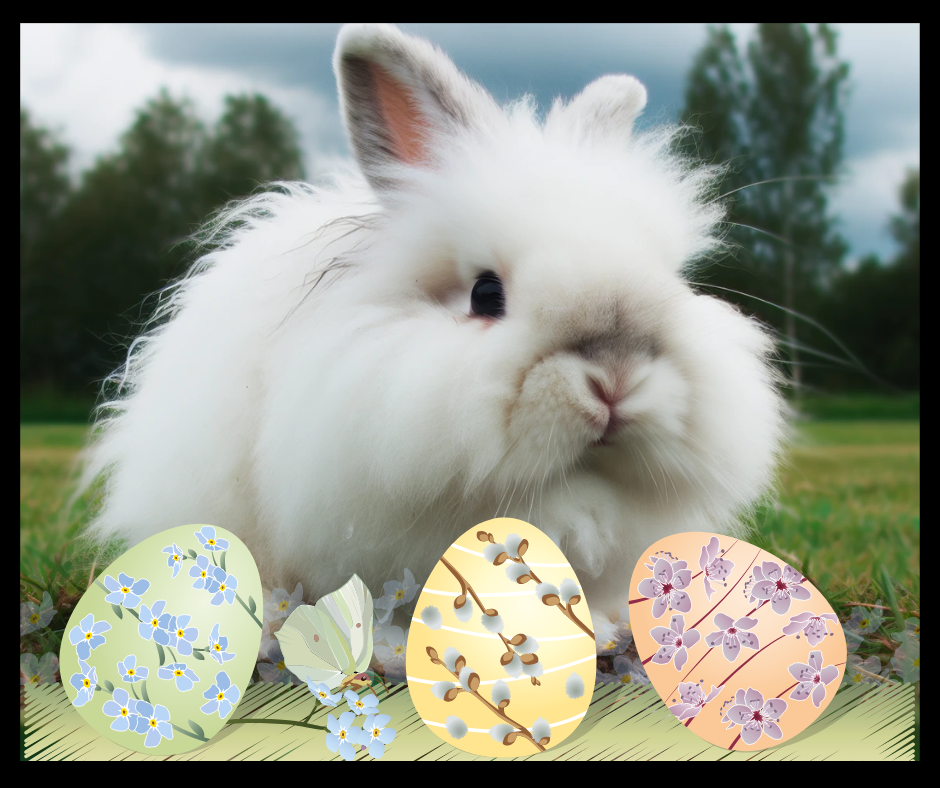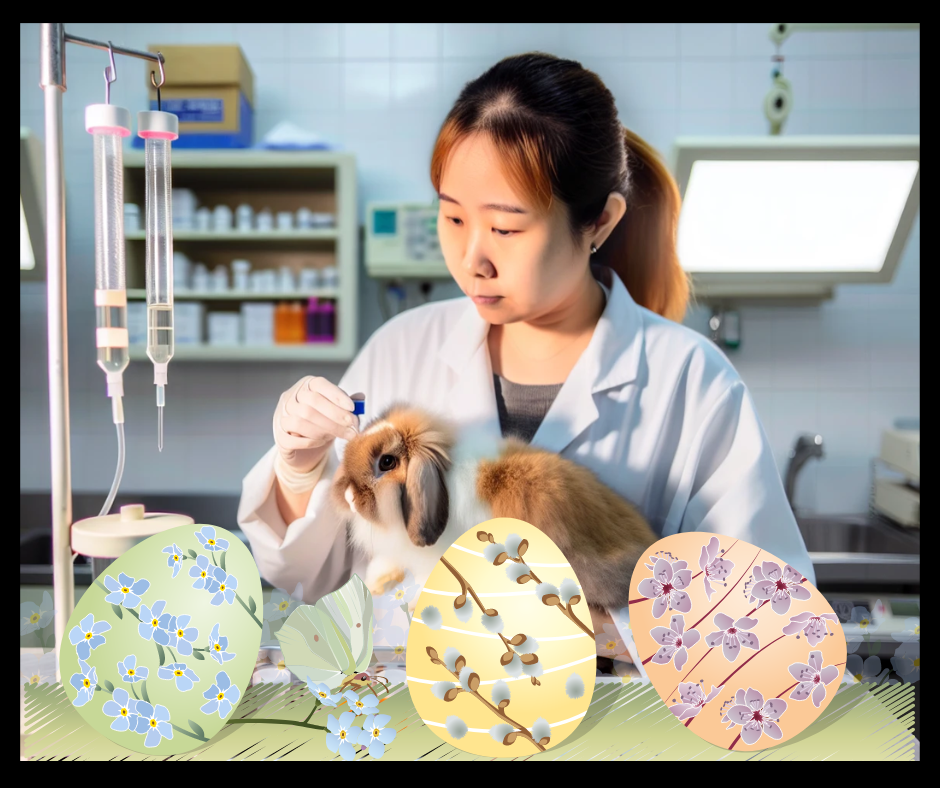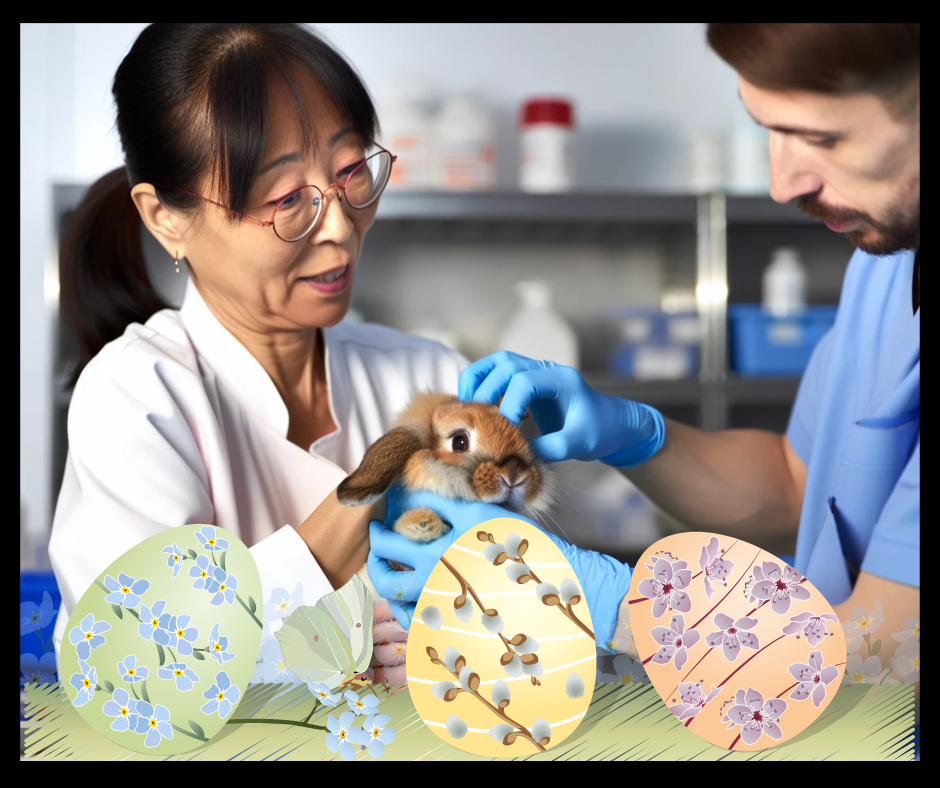Urinary tract infections (UTIs) in rabbits can cause discomfort and lead to severe health complications if left untreated. As a responsible rabbit owner, it’s essential to understand the UTI rabbit symptoms, causes, and treatment options for UTIs to ensure your furry friend remains healthy and happy. In this blog post, we will guide you through the process of identifying UTI rabbit symptoms, discuss common causes, outline diagnostic techniques, and explore treatment options and preventative measures.

Key Takeaways
-
Recognize and treat UTI symptoms in rabbits, such as painful urination, blood in the urine, and lethargy.
-
Common causes of urinary tract infections include high calcium diets, obesity, and inadequate cleaning.
-
Preventative measures for Rabbit UTIs include a balanced diet with hay & leafy greens, regular hygiene maintenance, and environmental enrichment to reduce stress.
Recognizing UTI Symptoms in Rabbits

Spotting UTI symptoms in rabbits aids in timely detection and efficient treatment. Common symptoms include:
-
Painful urination
-
Blood in the urine
-
Frequent urination
-
Lethargy accompanied by a loss of appetite
Observing your rabbit’s behavior and checking their urine allows detection of possible problems, enabling you to get the needed medical care.
We will examine each of these symptoms in depth.
Painful Urination
Painful urination is a common sign of UTIs in rabbits, often indicated by:
-
Straining or discomfort during urination
-
Frequent visits to the litter box
-
Urinating away from the litter box
-
Unwillingness to take their usual stance during urination
If you notice any of these signs, it’s important to consult a veterinarian for proper diagnosis and treatment.
In some cases, the urine may appear thick, beige or brown-colored, or cloudy-looking. If you notice any of these signs, consult a veterinarian for further evaluation and treatment, which may include fluid therapy.
Hematuria (Blood in Urine)
Hematuria, or the presence of blood in the urine, is another symptom of a possible UTI in rabbits and should be addressed promptly. The urine may appear discolored, typically pink, red, orange, amber, or brown, related to the amount of calcium excreted in the urine. Various factors, including kidney stones, bacterial bladder infections, and an increase in calcium in the blood, can cause hematuria.
If you suspect hematuria, consult a veterinarian for proper diagnosis and treatment.
Frequent Urination
Frequent urination can be a symptom of a UTI, as the rabbit may feel the constant urge to urinate due to irritation in the urinary tract. Changes in urination frequency, such as an increase or indications of straining, may be indicative of a urinary issue.
If you detect abnormal coloring, increased white blood cell counts, frequent urination, painful urination, or cloudy-looking urine, it may indicate a urinary tract infection or a urinary tract disease.
Under such circumstances, seeking a veterinarian’s advice is advisable.
Lethargy and Loss of Appetite
Lethargy and loss of appetite may indicate a UTI in rabbits, as they may feel unwell and uncomfortable due to the infection. Other associated symptoms may include cloudy or brownish urine and a change in behavior.
If you observe these signs in your rabbit, seek medical attention to ensure proper diagnosis and treatment.
Common Causes of Urinary Tract Infections in Rabbits

Understanding the common causes of UTIs in rabbits can help you take the necessary precautions to protect your pet. The usual sources of UTIs in rabbits include:
-
High calcium diets
-
Obesity
-
Inadequate cleaning
-
Bacterial infections
Mitigating these factors can reduce the chances of your rabbit getting a UTI.
We will detail each of these causes further.
High Calcium Diets
High calcium diets can contribute to the formation of bladder stones and increase the risk of UTI symptoms in rabbits. When rabbits are provided with a high calcium diet, their urinary calcium excretion is augmented while their urine volume remains constant. This discrepancy can raise the probability of urinary tract infections.
Preventing UTIs requires attentive monitoring of your rabbit’s calcium intake and modifying their diet as needed.
Obesity and Sedentary Lifestyles
Obesity and sedentary lifestyles can lead to a higher risk of UTIs in rabbits due to decreased mobility and poor overall health. Overweight rabbits may have difficulty accessing their anal region, which can impede their consumption of cecotrophs, further worsening their condition.
Ensuring that your rabbit maintains a healthy weight through a balanced diet and regular exercise can help prevent UTIs and improve their overall health.
Inadequate Cleaning
Inadequate cleaning of the rabbit’s living environment can lead to bacterial growth and increase the risk of UTIs. Escherichia coli and other microorganisms can proliferate in unsanitary rabbit habitats, leading to infections.
To prevent UTI symptoms in rabbits, maintain a clean and sanitized living environment, including regular litter box maintenance.
Bacterial Infections
Bacterial infections are a primary cause of urinary tract diseases, such as urinary tract infections, in rabbits and can be introduced through various sources. Escherichia coli, Pseudomonas spp., and Treponema paraluiscuniculi are frequently associated with urinary tract infections in rabbits.
Immediate treatment of bacterial infections is necessary to avoid additional complications and maintain your rabbit’s health.
Diagnostic Techniques for UTIs in Rabbits

Accurate diagnosis of UTI symptoms in rabbits is essential for proper treatment and recovery. Diagnostic techniques for UTIs in rabbits include urinalysis, radiography, and ultrasonography. These tests can help determine the presence of infections or other issues within the urinary tract and guide the veterinarian in prescribing the appropriate treatment.
We will scrutinize each of these diagnostic techniques further.
Urinalysis and Urine Culture
Urinalysis and urine culture are essential diagnostic tools for identifying UTIs in rabbits and determining the appropriate treatment. A urinalysis involves obtaining and evaluating a urine sample for various parameters to assess the rabbit’s urinary health. A urine culture allows for the identification of the specific strain of bacteria present in the urinary tract.
These tests are effective in diagnosing UTIs in rabbits and guiding treatment decisions.
Radiography (X-rays)
Radiography (X-rays) can help detect bladder stones or other abnormalities in the urinary tract that may contribute to UTIs. X-rays provide visual diagnostics of the lower urinary tract, aiding in the detection of stones or sludge in the bladder and urinary tract. X-rays may be taken after the rabbit is given an oral or injected contrast agent to enhance the visibility of the urinary system.
Regular and contrast X-rays can be valuable diagnostic tools for UTIs.
Ultrasonography
Ultrasonography is a non-invasive diagnostic tool that can provide detailed images of the rabbit’s urinary tract to identify potential issues. This imaging technique utilizes sound waves to create images of the interior of the body, allowing veterinarians to visualize and assess the structures and organs within the urinary tract.
Ultrasonography can help identify issues such as urinary bladder transitional cell carcinoma, lower urinary tract infections, urolithiasis (urinary stones), and other urinary tract diseases.
Treatment Options for Rabbits with UTIs

Once a UTI has been diagnosed, appropriate treatment is essential for your rabbit’s recovery. Treatment options for rabbits with UTIs include:
-
Antibiotics
-
Dietary changes
-
Increased water consumption
-
Exercise
The specific treatment plan will depend on the underlying cause of the infection and the severity of your rabbit’s condition.
We will go into each of these treatment options more thoroughly.
Antibiotics
Antibiotics, such as enrofloxacin or trimethoprim-sulfa, are commonly prescribed to treat UTIs in rabbits. The choice of antibiotic and duration of treatment will depend on the specific strain of bacteria causing the infection, as determined by a urine culture.
Following your veterinarian’s instructions and completing the full course of antibiotics is vital for effective treatment and preventing a relapse.
Dietary Changes
Dietary changes, including reducing calcium intake, can help prevent the formation of bladder stones and reduce the risk of UTIs in rabbits. A suitable diet includes:
-
Grass hay
-
Freshwater
-
A reduction in pellet volume
-
Increasing loose grass hay and greens in their diet
Offering your rabbit a balanced diet fosters urinary health, including the rabbit’s urinary tract and rabbit’s urinary pathway, and helps prevent subsequent infections.
Increased Water Consumption
Encouraging increased water consumption can help flush out bacteria and promote overall urinary tract health in rabbits. Increased water intake can dilute the urine, flush out bacteria, and promote urination, which facilitates the treatment of urinary tract infections in rabbits.
Ensure your rabbit has access to fresh water at all times, and consider providing water-rich foods such as celery, lettuce, and carrots to promote hydration.
Exercise and Weight Loss
Exercise and weight loss can improve a rabbit’s overall health and reduce the risk of UTIs. Ensuring that your rabbit maintains a healthy weight through a balanced diet and regular exercise can help prevent UTIs and improve their overall health.
Providing a large exercise area and encouraging bladder emptying can support proper urinary flow and urinary health and prevent lower urinary tract infections. Additionally, it may help restore proper urinary flow in some cases, potentially alleviating urine retention.
Preventative Measures for Rabbit UTIs

Taking preventative measures can help reduce the risk of UTI symptoms in your rabbit. Proper diet, hygiene, and environmental enrichment are crucial factors in maintaining your rabbit’s overall health and preventing UTIs. By addressing these factors, you can ensure a healthy, happy life for your furry friend.
We will talk about each of these preventative measures further.
Diet and Nutrition
A balanced diet with appropriate calcium levels can help prevent bladder stones and reduce the risk of UTIs in rabbits. Ensure your rabbit receives important nutrients such as:
-
Proteins
-
Carbohydrates
-
Lipids (or fats)
-
Minerals
This can be achieved through a diet predominantly consisting of hay, along with a daily serving of leafy greens and a small portion of other foods.
Hygiene and Litter Box Maintenance
Regular cleaning and maintenance of the rabbit’s living environment, including litter boxes, can help prevent bacterial growth and UTI symptoms. Clean the litter box at least every two to four days for a single rabbit that uses multiple boxes.
To encourage increased water intake, utilize a water dish instead of a sipper bottle and provide water-rich foods such as celery, lettuce, and carrots.
Environmental Enrichment
Providing environmental enrichment for rabbits can encourage exercise and promote overall health, reducing the risk of UTIs. Here are some ways to do this:
-
Incorporate structures, furniture, and substrates for digging or dusting
-
Provide suitable enrichment such as roughage, hay blocks, and chew sticks
-
Create hiding spots and an area for withdrawal and lookout
By implementing these strategies, you can help keep your rabbit active and healthy.
This can provide your rabbit with a stimulating environment, reduce stress, and promote physical and mental stimulation.
Summary

Urinary tract infections in rabbits can be a serious health concern if not addressed promptly. By recognizing UTI symptoms, understanding common causes, and employing diagnostic techniques, you can ensure proper treatment and recovery for your rabbit.
Implementing preventative measures such as a balanced diet, proper hygiene, and environmental enrichment can reduce the risk of UTIs and promote overall health in your furry friend. Stay vigilant and proactive in your rabbit’s care to ensure they lead a happy and healthy life.
Frequently Asked Questions
How do I know if my bunny has a UTI?
If your bunny attempts to pass urine but only passes a few drops or none at all, has blood in the urine, hops in and out of the litter tray more than normal, and vocalizes with pain, it may suffer from a UTI. Seek medical attention for your rabbit right away.
What are the symptoms of urine scald in rabbits?
Urine Scald in rabbits is characterized by redness, balding, and crusting of the fur around the hindquarters, tail, and belly. It may also cause irritation, pain, and discomfort in the affected area.
Why is my rabbit dribbling pee?
My rabbit is likely dribbling pee due to excess calcium excreted in the form of calcium carbonate. This substance can make normal rabbit urine cloudy and dry into a white residue on cage paper.
Other signs to look out for are straining, dripping urine, or avoidance of the litterbox. To prevent sludge, ensure your rabbit is getting enough exercise, hydration, and an appropriate diet.
What is cystitis in rabbits?
Cystitis is an inflammation of the urinary bladder in rabbits that may be caused by a primary infection or a secondary problem related to another underlying condition. Infection is one of the possible causes of cystitis.
What should you do if your rabbit has a urinary tract infection?
If your rabbit has a urinary tract infection, it is essential to seek veterinary treatment, which may include antibiotics and pain relief. Urine scalding will also require careful clipping and cleaning of the affected area (which may require sedation), pain relief, and sometimes topical or systemic antibiotics.
Learn Rabbit Care, Tips, and Tricks!
Learn more about caring for your bunny with us. We’ve got everything from rabbit hutches to essential care tips.
For more information on rabbit care, visit our website: therabbithop.com.
Join our community and become a bunny care expert!



